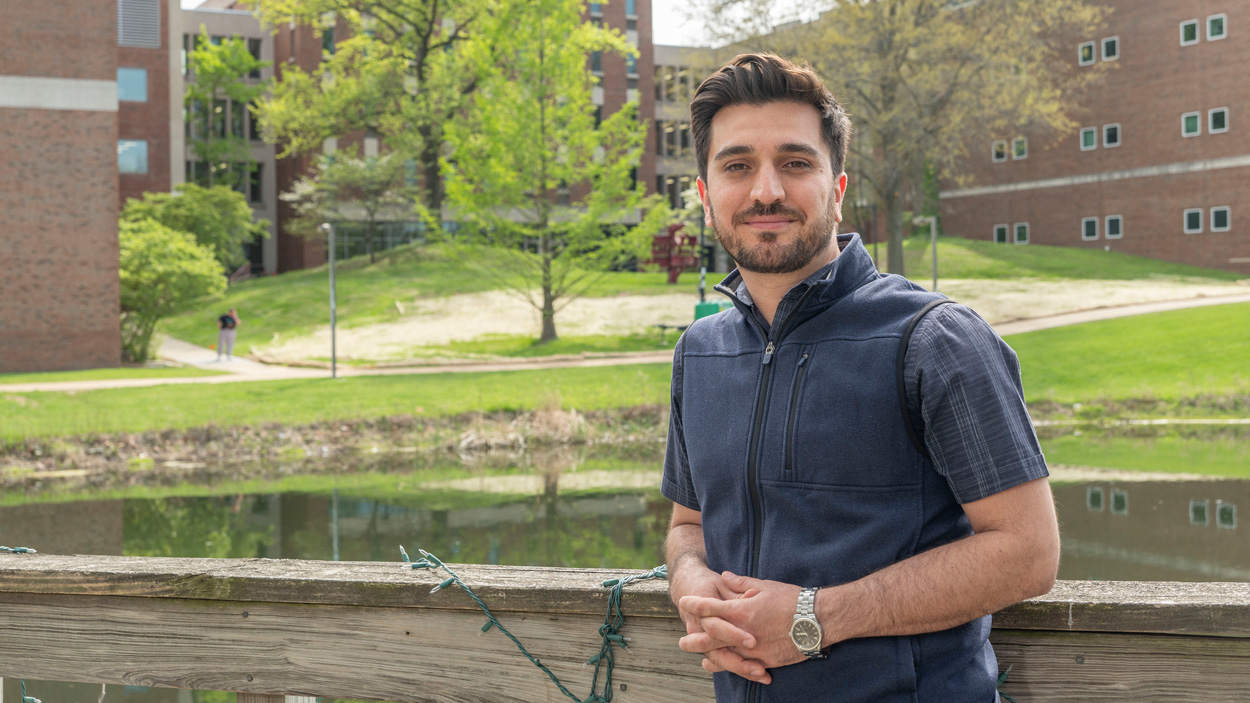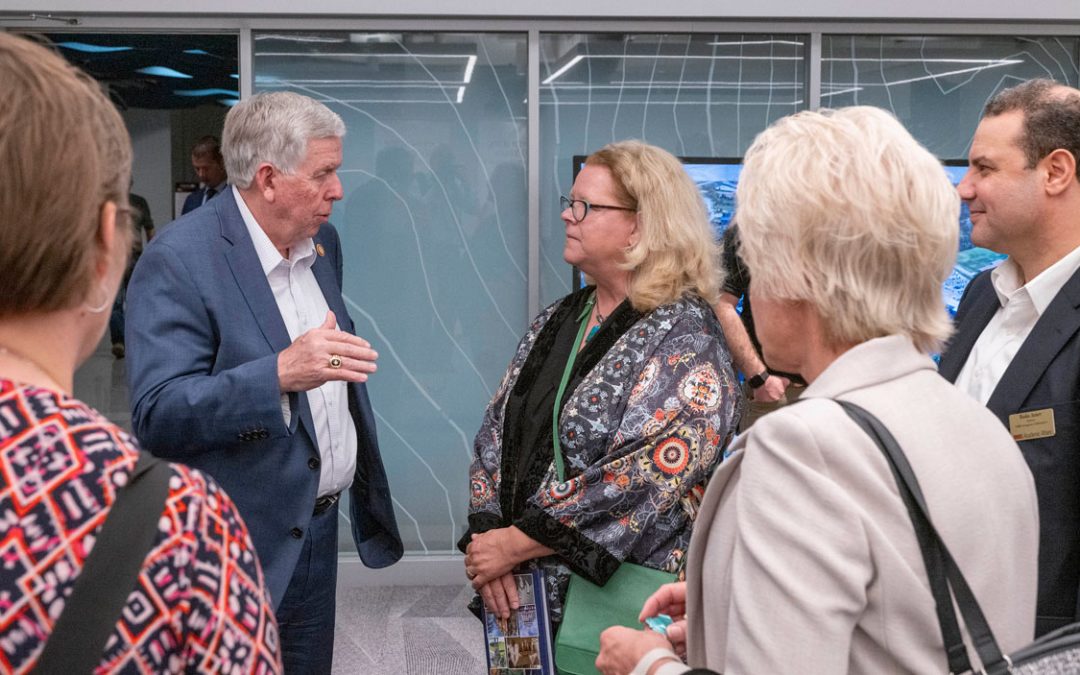
Mohi Saki, an assistant professor of physics and astronomy, has been granted 13.1 hours of observation time on the James Webb Space Telescope to study six Halley-type comets. Over the course of about a year, Saki and his six co-principal investigators will study the composition of the comets with the Webb Telescope’s high-resolution spectroscopy. (Photo by Derik Holtmann)
When Mohi Saki submitted a proposal for research time on NASA’s James Webb Space Telescope, he estimated there was about a 5% chance it would be accepted.
Securing time on the telescope is a highly competitive process, so it felt like winning the cosmic lottery when Saki received an email in March notifying him that his study had been approved. Saki, an assistant professor of physics and astronomy at the University of Missouri–St. Louis, was walking to class when he got the news.
“I was just screaming,” he said, recalling the moment. “It’s so amazing. I couldn’t believe it.”
Saki, who is also an UMSL graduate, has been granted 13.1 hours of observation time on the Webb Telescope beginning in this July to study six Halley-type comets – those with orbital periods less than 200 years. Due to their lengthy orbits, they only appear once, maybe twice, in one’s lifetime.
“Last time most of them were around, we didn’t have the technology to study them back in the ’80s, ’90s,” Saki explained. “We didn’t have the sensitivity that we have today with our instruments. Right now, we do, and we have a bunch of them coming in to the inner parts of the solar system. So, we really put together a clever proposal going after these comets with the technology that we have. By the time our proposed targets come back, it will be another 70 years.”
Over the course of about a year, Saki and his six co-principal investigators will study the composition of the six Halley-type comets with the Webb Telescope’s high-resolution spectroscopy. They will then compare their results to data on comets with shorter orbital periods and comets with even longer orbital periods.
His partners on the project include Erika Gibb, professor and chair of the Department of Mathematics, Physics, Astronomy and Statistics at UMSL; Dennis Bodewits, professor of astrophysics at Auburn University; Youssef Moulane, research scientist at Mohammed VI Polytechnic University; John W. Noonan, postdoctoral research fellow at Auburn University; Nathan X. Roth, research assistant professor of physics at American University; and Stefanie N. Milam, deputy project scientist for planetary science at the NASA Goddard Space Flight Center.
Saki’s interest in space began with a desire to investigate the unknown, which led him to earn a bachelor’s degree in physics from Kharazmi University and a master’s degree in computational physics from Amirkabir University of Technology in his native Iran. In 2015, Saki came to UMSL to pursue a second master’s degree in physics and astronomy.
He went on earn his PhD in physics from Missouri University of Science and Technology, though he was able to continue his research at UMSL. He then served as a postdoctoral researcher at Auburn for two years before returning to UMSL last year.
The programs at UMSL and Missouri S&T were rigorous but also rewarding.
“It’s very competitive,” he said. “The subjects are very difficult. There are lots of things to learn, a lot of new things that you have to teach to yourself. So, it was very challenging, but at the same time, it’s pretty fascinating because you’re learning things that are building blocks of nature. We learn the rules that govern the universe.”
Saki added that UMSL is one of the few institutions in the country – Johns Hopkins University and NASA being the others – where one can be trained to conduct research on comets in the near infrared spectrum. His research concentration makes the opportunity to log time on the Webb Telescope all the more exciting.
The Webb Telescope is the most advanced telescope in the world available to scientists like Saki. With it, researchers are able to observe the infrared spectrum – the 1 to 30 micron wavelength.
“The reason this is significant is because many of these celestial bodies are moving so rapidly away from us that their light features, or photons, shift completely from the visible part of the wavelength spectrum, which is what the Hubble Space Telescope excels at,” Saki explained. “They have shifted enough that they are no longer visible. The light moves to the infrared spectrum, so if you wanted to study them using the Hubble Space Telescope, you would not see anything because they lack visible light features. The shift extends all the way to infrared, and that is where the strength of the Webb Telescope comes into play.”
The high sensitivity of the Webb Telescope makes it possible to distinguish individual lines of photons from one another, which is key to observing a comet’s coma, the nebulous atmosphere of sublimated gas and dust surrounding the nucleus.
Saki and his partners at American, Auburn, Mohammed VI Polytechnic, NASA and UMSL plan to study the coma composition of the six Halley-type comets with the Webb Telescope’s high-resolution spectroscopy. Based on the composition of the coma, they can then extrapolate the composition of the solid nucleus.
“Why is it important?” Saki said. “Because these comets are building blocks of the entire solar system.”
The Halley-type comets Saki and his colleagues have identified were formed around the time Jupiter, Saturn, Uranus and Neptune moved into their orbits, scattering the pieces left behind during planet formation, e.g. comets, throughout the entire solar system. Because of their long orbital periods, much of that time being outside of the inner solar system, the comets should still contain their initial composition.
“We can learn about the composition of the nucleus, which in turn gives us information about the composition of the planetary-formation region,” Saki said. “That’s the whole purpose of it, to understand what our solar system was like 4.5 billion years ago when it was formed.”
The team’s observations will be spread out over the course of a year because the six comets will pass through the inner solar system at different times. Saki said the project will start with three observations from July to August, then one from January to February next year, another from March to May and the final observation will be from May to June 2025.
The researchers will then compare their findings to available data on Jupiter-family comets, those with short orbital periods, which frequently travel through the inner solar system and are thought to suffer the most from thermal processing. They will also compare the findings to available data on Oort-Cloud comets, which have orbital periods of thousands of years.
“What we’re hoping to see is if these two different classes can be connected with our measurements,” Saki said.
Saki anticipates publishing at least four academic papers related to the project and hopes to submit at least one to Nature, a leading weekly scientific journal. Whatever the comets reveal, Saki is excited to be on the verge of discovery.
“It’s just amazing,” he said. “I feel like we are on to something very special. Once we have these comets – this category of comets that is well under-represented in the whole class of comets – I think we could probably say that we have added a few pieces to the puzzle. Now we can have a better picture of what the early solar system was like.”














